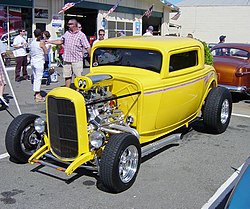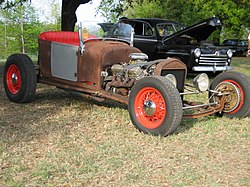Hot rod: Difference between revisions
m Undid revision 206073732 by Wilberding (talk) rv linkspam |
Wilberding (talk | contribs) added external links |
||
| Line 86: | Line 86: | ||
*[http://www.modsandrodders.co.uk Mods 'n' Rodders] |
*[http://www.modsandrodders.co.uk Mods 'n' Rodders] |
||
*[http://www.webrodder.com WebRodder Hot Rod Tech] |
*[http://www.webrodder.com WebRodder Hot Rod Tech] |
||
*[http://www.webridestv.com/searchresults.aspx?searchterms=hot%20rods Popular Hot Rods] |
|||
*[http://www.chevrolet.com/chevyracing/nhra/ Team Chevy — An American Revolution] |
|||
[[Category:Vehicle modification]] |
[[Category:Vehicle modification]] |
||
Revision as of 14:16, 17 April 2008





Hot rods are typically American cars with large engines modified for linear speed. Nobody knows for sure the origin of the term "hot rod." One explanation is that the term is a contraction of "hot roadster," meaning a roadster that was modified for speed. Open roadsters were the cars of choice to modify because they were light. Hot Rod may also refer to the connecting rods, cam, or pushrods inside the engine or to the exposed frame rails of such an automobile. It has also been noted that burning out the connecting rod bearings was a very common failure mode for souped up four-cylinder Fords, particularly the Model T, and "hot rod" could refer to that phenomenon. It was adopted in the 1930s or 1940s as the name of a car that had been "hopped up" by modifying the engine in various ways to achieve higher performance.
The term can also apply to other items that are "souped up" for a particular purpose, such as "hot-rodded amplifier".
History
The term seems first to have appeared in the late 1930s, when kids from southern California would race their modified cars on the vast, empty dry lake beds northeast of Los Angeles under the rules of the Southern California Timing Association. The activity increased in popularity after World War II, particularly in California, due to returning soldiers, many of whom had been given technical training in the service. The original hot rods were old cars (most often Fords, typically Model Ts, Model As, or 1932 to 1934 Model Bs or V-8s) that had been modified by to reduce weight and improve aerodynamics. Typical modifications were removal of convertible tops, hood, bumpers, windshields, and/or fenders); lowering the chassis; and modifying the engine by tuning and/or replacing with a more powerful type. Wheels and tires were changed for improved traction and handling. "Hot Rod" was sometimes a term used in the 1950s as a derogatory term for any car that did not fit into the mainstream. Hot rodder's modifications were considered to improve the appearance as well, leading to show cars in the 1960s replicating these same modifications along with a distinctive paint job.
After World War II there were many small military airports throughout the country that were either abandoned or vary rarely used that allowed Hot Rodders across the country to race on marked courses. Originally Drag Racing had tracks that may have been as long as 1 mile or more, and included up to 4 lanes of racing at the same time. As hot rodding became more popular in the 1950s, magazines and associations catering to Hot Rodders were started. As Hot Rodders began to race on the street in addition to drag strips, a need arose for an organization to promote the images of Hot Rodders. Hot rodders including Wally Parks created the National Hot Rod Association NHRA to bring racing off the streets and onto the tracks. They created rules based on safety an entertainment, and allowed Hot Rodders of any caliber the ability to race. The annual California Hot Rod Reunion and National Hot Rod Reunion are held to honor pioneers in the sport. The Wally Parks NHRA Motorsports Museum houses the roots of hot rodding.
As automobiles offered from the major automakers began increasing performance, the lure of Hot Rods began to wane. You no longer needed to put a Cadillac engine in a Ford roadster to be fast. You could now buy a Pontiac GTO that out performed your Hot Rod, and still have enough room to fit the wife and kids. After the 1973 Oil Crisis the public called on automakers to offer safety and fuel efficiency over performance. This led to a resurgence of Hot Rodding, although the focus was on driving Hot Rods over racing so the term 'Street Rod' was coined to denote a vehicle manufactured prior to 1949, often with a late model drivetrain for reliability. Street Rodding as it was now known was a different phenomenon that Hot Rodding, as Street Rodding was mainly family oriented. National events were hosted by the National Street Rod Association (NSRA), which also stressed safety as the NHRA did 20 years before, but this was safety for the street as opposed to on the race track. Each NSRA event has a 'Safety Inspection Team' that performs a 23 points inspection process that goes beyond what normal State Safety Inspections Require.
Nowadays people who own hot rods keep them clean and try to make them noticeable. There are many different sects of Hot Rodding now, there are Billet Rods (noted by many items being made from Billet aluminum), Traditional Rods (those that built according to a particular point in time and stick to those build techniques and materials), Rat Rods (those that are pieced together to look like old time jalopies, although some times they require more work than a show rod), and Show Rods (Hot Rods created to compete in National Car Shows such as AMBR (America's Most Beautiful Roadster), and the Detroit Autorama). Although collectively they are all referred to as Hot Rods. There are many magazines that feature real hot rods, including The Rodders Journal, Hot Rod Magazine, Rod and Custom Magazine, Street Rodder, and Popular Hot Rodding. There are also television shows such as My Classic Car, and Horsepower TV. Hot rods are part of American culture, although there is growing controversy within the automotive hobby over an increasing trend towards the acquisition and irreversible modification of surviving historic - some even very rare - vehicles rather than the traditional hot rodding concept of the salvage and remanufacture of reusable junked parts.
Author Tom Wolfe was one of the first to recognize the importance of hot rodding in popular culture and brought it to mainstream attention in his book The Kandy-Kolored Tangerine-Flake Streamline Baby.
Hot Rod era
The Hot Rod era extended from 1930 to the beginning of the muscle car era (about 1965), reaching its height in about 1955. During this time, there was an adequate supply of what hot rodders called "vintage tin": junk cars manufactured prior to 1942 that could be had cheaply. Many of these had sound bodies and frames, and had been junked for mechanical reasons, since the running gear of early cars was not durable. The typical hot rod was heavily modified, particularly by replacing the engine and transmission, and possibly other components, including brakes and steering. Certain engines, such as the flathead Ford V8, and the small block Chevrolet V8 were particularly popular as replacements because of their compact size, availability, customization and power. The early Hemi was popular in applications that required more power, such as drag racing. More recently, more unusual engines have become popular to use in hot rods, notably the Cadillac 500 and the Buick "NailHead".
Construction of a hot rod requires skills in mechanics, welding, and automotive paint and body work.
The "classic era" of hot rod construction ended around 1965, partly because the supply of vintage tin had diminished, but mostly because new cars were equipped for greater speed and power from the factory with little or no modification required.
Today, there are still a large number of hot-rodders and street-rodders. The Street Rod Nationals serves as a showplace for the majority of the hot-rodding and street-rodding world to display their cars and to find nearly any part needed to complete them.
Today
There is still a vibrant Hot Rod culture worldwide, especially in the United States and Sweden. The hot rod community has now been subdivided into two main groups: hot rodders and street rodders. Hot rodders build their cars using a lot of original, old parts, and follow the styles that were popular from the 1940s through the 1960s. Street rodders build cars (or have them built for them) using, primarily, new parts.
Street rod builder Boyd Coddington starred in American Hot Rod, a documentary series on Discovery channel until his death in 2008.
The Discovery Channel airs several shows dealing with modern interpretations of kustom kulture such as Monster Garage, American Hot Rod, and Overhaulin'.
Juxtapoz Magazine, founded by the artist Robert Williams, has thrived as a recent extrapolation of kustom kulture art. It has also begun to garner respect as an exhibitor of contemporary artistic talent that transcends kustom kulture's bounds.
There is a contemporary movement of traditional hot rod builders, car clubs and artists who have returned to the roots of hot rodding as a lifestyle. This current traditional hot rod culture is exemplified in a whole new breed of traditional hot rod builders, artists and styles, as well as classic style car clubs like the Deacons, the Shifters, and the Dragoons. Events like Viva Las Vegas, and GreaseOrama showcase this return to traditional hot rods and the greaser lifestyle. Underground magazines like Garage, Rolls & Pleats, and BurnOut showcase this return to traditional hot rods by covering events and people around the world. There are number of independently released DVDs featuring this traditional hot rod revival with names such as Mad Fabricators, Hot Rod Surf ‘All Steel All Real’, and Hot Rod Havoc.
The culture is vibrant in Sweden where there are many automobile enthusiasts. Meetings like Power Big Meet and clubs such as Wheels and Wings in Varberg, Sweden have established themselves in Swedish Hot Rod culture. Since there is very little "vintage tin" the hot rods in Sweden are generally made with a home made chassis (usually a Ford model T or A replica), with a Jaguar (or Volvo 240) rear axle, a small block V8, and fiberglass tub, but some have been built using for instance a Volvo Duett chassis. Because the Swedish regulations required a crash test even for custom-built passenger cars between 1969 and 1982 the Duett option was often used since it was considered a rebodied Duett rather than a new vehicle.[1][2][3][4][5][6]
Some 1950s and 1960s cars are also hot rodded, like Morris Minor, Ford Anglia, Volvo Amazon, Ford Cortina, '57 Chevy, to name but a few.
New "Retro Inspired" steel bodies
As the supply of original steel bodies dwindles to nothing, those who reject fiberglass replicas can buy new reproduction bodies. They are not actual antiques, but often are superior in some aspects such as build quality to original hot rod bodies. The best bodies can command a price of US $10,000 or more.
See also
- Automobile
- Automotive restoration
- Boy racer
- Custom car
- Cutdown
- Hot hatch
- Import Scene
- Kustom Kulture
- Lowrider
- Muscle car
- National Street Rod Association
- Plymouth Prowler - a modern take on the "hot rod" concept
- Pro Street
- Rat rod - a controversial hot rod term.
- T-bucket - a style of hot rod based on a Ford Model T
- Three window coupe - one of the classic hot rod styles
- Volvo T6 - a Volvo concept car with obvious hot rod inspiration
- Volksrods
External links
- V8Hotrod.com Online Hot Rod Magazine
- Hot Rod Magazine
- Rod & Custom Magazine
- Popular Hot Rodding
- Street Rodder
- Southern California Time Association (SCTA)
- National Hot Rod Association
- National Street Rod Association (NSRA)
- Mods 'n' Rodders
- WebRodder Hot Rod Tech
- Popular Hot Rods
- Team Chevy — An American Revolution
